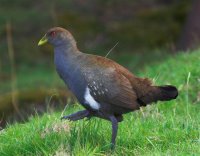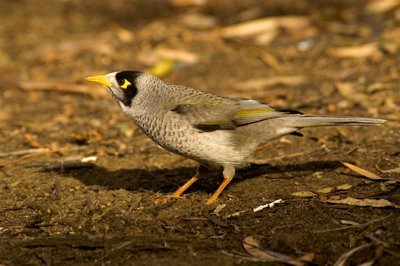 I've always been intrigued by the ever changing breakdown of species that inhabit my back garden. Over the years a number of large trees, mainly European species have been removed and others, mainly West Australian eucalypts, have supplanted them. The movement of the 70s and 80s encouraging householders to 'go native', have seen many changes to mine and the surrounding gardens. The downside of this has been that, as the trees and shrubs have matured, a few species have dominated. Gone, except as very occasional visitors, are the smaller honeyeaters that frequented this area, particularly in the Winter, replaced by the 'bullies', the Little Wattlebirds and the Noisy Miners. A few others manage a living, Musk Lorikeets, Eastern Rosellas, the odd Crescent Honeyeater, and even an occasional (and welcome) Yellow-tailed Black Cockatoo. Of course, we have almost the full range of exotics too! The Noisy Miners started using the garden in numbers, in the mid 80s, and now are regular visitors, harried, but unbowed, by the resident breeding pairs of Little Wattlebird. The Tasmanian sub species of the Noisy Miner, is substantially larger than the its Mainland cousins (Bergman's Rule kicking in). Perhaps that goes some way to explaining why the Noisy Miner I photographed this morning (top right) in a beachside car park, was drawn to a discarded meat pie, although I couldn't determine whether it was eating the meat or the pastry!
I've always been intrigued by the ever changing breakdown of species that inhabit my back garden. Over the years a number of large trees, mainly European species have been removed and others, mainly West Australian eucalypts, have supplanted them. The movement of the 70s and 80s encouraging householders to 'go native', have seen many changes to mine and the surrounding gardens. The downside of this has been that, as the trees and shrubs have matured, a few species have dominated. Gone, except as very occasional visitors, are the smaller honeyeaters that frequented this area, particularly in the Winter, replaced by the 'bullies', the Little Wattlebirds and the Noisy Miners. A few others manage a living, Musk Lorikeets, Eastern Rosellas, the odd Crescent Honeyeater, and even an occasional (and welcome) Yellow-tailed Black Cockatoo. Of course, we have almost the full range of exotics too! The Noisy Miners started using the garden in numbers, in the mid 80s, and now are regular visitors, harried, but unbowed, by the resident breeding pairs of Little Wattlebird. The Tasmanian sub species of the Noisy Miner, is substantially larger than the its Mainland cousins (Bergman's Rule kicking in). Perhaps that goes some way to explaining why the Noisy Miner I photographed this morning (top right) in a beachside car park, was drawn to a discarded meat pie, although I couldn't determine whether it was eating the meat or the pastry!
Tasmania,island state of Australia. Alan Fletcher's occasional blog about the enjoyment of birding in Tasmania.If your interest is images, visit my pbase site (see "links"). All images are copyright owned by their authors. If you wish to use any, please ask E-mail: tassiebirds@iinet.net.au
Thursday, June 29, 2006
Changing Habitat
 I've always been intrigued by the ever changing breakdown of species that inhabit my back garden. Over the years a number of large trees, mainly European species have been removed and others, mainly West Australian eucalypts, have supplanted them. The movement of the 70s and 80s encouraging householders to 'go native', have seen many changes to mine and the surrounding gardens. The downside of this has been that, as the trees and shrubs have matured, a few species have dominated. Gone, except as very occasional visitors, are the smaller honeyeaters that frequented this area, particularly in the Winter, replaced by the 'bullies', the Little Wattlebirds and the Noisy Miners. A few others manage a living, Musk Lorikeets, Eastern Rosellas, the odd Crescent Honeyeater, and even an occasional (and welcome) Yellow-tailed Black Cockatoo. Of course, we have almost the full range of exotics too! The Noisy Miners started using the garden in numbers, in the mid 80s, and now are regular visitors, harried, but unbowed, by the resident breeding pairs of Little Wattlebird. The Tasmanian sub species of the Noisy Miner, is substantially larger than the its Mainland cousins (Bergman's Rule kicking in). Perhaps that goes some way to explaining why the Noisy Miner I photographed this morning (top right) in a beachside car park, was drawn to a discarded meat pie, although I couldn't determine whether it was eating the meat or the pastry!
I've always been intrigued by the ever changing breakdown of species that inhabit my back garden. Over the years a number of large trees, mainly European species have been removed and others, mainly West Australian eucalypts, have supplanted them. The movement of the 70s and 80s encouraging householders to 'go native', have seen many changes to mine and the surrounding gardens. The downside of this has been that, as the trees and shrubs have matured, a few species have dominated. Gone, except as very occasional visitors, are the smaller honeyeaters that frequented this area, particularly in the Winter, replaced by the 'bullies', the Little Wattlebirds and the Noisy Miners. A few others manage a living, Musk Lorikeets, Eastern Rosellas, the odd Crescent Honeyeater, and even an occasional (and welcome) Yellow-tailed Black Cockatoo. Of course, we have almost the full range of exotics too! The Noisy Miners started using the garden in numbers, in the mid 80s, and now are regular visitors, harried, but unbowed, by the resident breeding pairs of Little Wattlebird. The Tasmanian sub species of the Noisy Miner, is substantially larger than the its Mainland cousins (Bergman's Rule kicking in). Perhaps that goes some way to explaining why the Noisy Miner I photographed this morning (top right) in a beachside car park, was drawn to a discarded meat pie, although I couldn't determine whether it was eating the meat or the pastry!
Tuesday, June 27, 2006
Yellow-rumps
 I was returning from Little Swanport on Monday (see posting below), and pulled in to the side of the road, just South of the Triabunna bridge, to count a small flock of Pelican. As I did, I noticed a robin on the fence wire, hunting insects. Using the car as a hide, I positioned myself to get a shot or two. The female Scarlet Robin (at left) was very obliging, returning to the same spot on the wire between sorties. As I concentrated on photographing this robin, I heard the familiar "tinkling" of Yellow-rumped Thornbills, but took little notice. The continued "tinkling" eventually got my attention--the flock of about 6 or 7 birds, had landed on the wire alongside me and much closer than the robin. A hurried change of angle, enabling me to take a few shots (one shown at lower left), before the flock
I was returning from Little Swanport on Monday (see posting below), and pulled in to the side of the road, just South of the Triabunna bridge, to count a small flock of Pelican. As I did, I noticed a robin on the fence wire, hunting insects. Using the car as a hide, I positioned myself to get a shot or two. The female Scarlet Robin (at left) was very obliging, returning to the same spot on the wire between sorties. As I concentrated on photographing this robin, I heard the familiar "tinkling" of Yellow-rumped Thornbills, but took little notice. The continued "tinkling" eventually got my attention--the flock of about 6 or 7 birds, had landed on the wire alongside me and much closer than the robin. A hurried change of angle, enabling me to take a few shots (one shown at lower left), before the flock 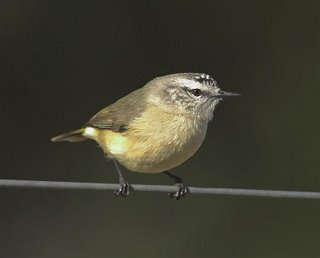 moved on. While the shot suffers somewhat from having a dark background, I was pleased to have come to grips with a common enough bird, but one that had eluded me (as far as photos go) . Are there less of them around this Winter? As I continued on my way feeling quite pleased with my good fortune, I realised that I never did count the pelican!
moved on. While the shot suffers somewhat from having a dark background, I was pleased to have come to grips with a common enough bird, but one that had eluded me (as far as photos go) . Are there less of them around this Winter? As I continued on my way feeling quite pleased with my good fortune, I realised that I never did count the pelican!
Monday, June 26, 2006
Saltworks Excursion
 On a beautiful Winters morning after a hard frost, I decided on a foray to the Saltworks Reserve, North of Triabunna. Scenically, probably one of the best, the picture at right was taken from the mouth of Little Swanport, looking inland. The spit in the middle ground, had a roost of some 32 Australian Pelicans this morning, 2 of which were banded(rt leg). Other birds occupying that beach included, c.10 Red-necked Stint, 2 Hooded Plover, several Pacific Gulls, c.15 Red-capped Plover
On a beautiful Winters morning after a hard frost, I decided on a foray to the Saltworks Reserve, North of Triabunna. Scenically, probably one of the best, the picture at right was taken from the mouth of Little Swanport, looking inland. The spit in the middle ground, had a roost of some 32 Australian Pelicans this morning, 2 of which were banded(rt leg). Other birds occupying that beach included, c.10 Red-necked Stint, 2 Hooded Plover, several Pacific Gulls, c.15 Red-capped Plover and 2 pairs of Pied Oystercatcher. The most numerous species was Crested Tern, probably numbering 150+, but as they constantly passed from the oyster racks out to sea and back, that's a guess. Several of the Pelicans took off and headed North (including the one pictured). Other birds present in the area, included Little Pied Cormorant, Black-faced Cormorant, Australasian Gannet, Grey Butcherbird, White-faced Heron, Grey Currawong, and a solitary White-breasted Sea Eagle. En route, I stopped briefly at Rostrevor Lagoon (about 1 km N.of Triabunna), and noted at least 12 Blue-billed Duck and 20+ Blue-winged Shoveller. Rostrevor is, arguably, the most consistent spot in Tasmania to see Blue-bills.
and 2 pairs of Pied Oystercatcher. The most numerous species was Crested Tern, probably numbering 150+, but as they constantly passed from the oyster racks out to sea and back, that's a guess. Several of the Pelicans took off and headed North (including the one pictured). Other birds present in the area, included Little Pied Cormorant, Black-faced Cormorant, Australasian Gannet, Grey Butcherbird, White-faced Heron, Grey Currawong, and a solitary White-breasted Sea Eagle. En route, I stopped briefly at Rostrevor Lagoon (about 1 km N.of Triabunna), and noted at least 12 Blue-billed Duck and 20+ Blue-winged Shoveller. Rostrevor is, arguably, the most consistent spot in Tasmania to see Blue-bills.
Friday, June 23, 2006
Small Influx and A Puzzle
 I suppose that one advantage of walking the same area frequently, is that you may notice small nuances of bird behaviour or numbers. My almost daily walk, takes me past adjoining gardens, past tree lined ovals and includes a small headland reserve, which includes a rocky shore. Yesterday, which was a little warmer than of late, I saw quite an increase in birds that infrequently are seen on this walk. They included several Eastern Spinebills, Grey Fantails, Yellow-throated Honeyeaters and a few Scarlet Robins. I alluded to it being a little warmer than of late, earlier, and I can only suppose that this may have caused the very welcome increase.
I suppose that one advantage of walking the same area frequently, is that you may notice small nuances of bird behaviour or numbers. My almost daily walk, takes me past adjoining gardens, past tree lined ovals and includes a small headland reserve, which includes a rocky shore. Yesterday, which was a little warmer than of late, I saw quite an increase in birds that infrequently are seen on this walk. They included several Eastern Spinebills, Grey Fantails, Yellow-throated Honeyeaters and a few Scarlet Robins. I alluded to it being a little warmer than of late, earlier, and I can only suppose that this may have caused the very welcome increase. 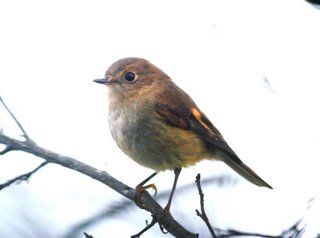
Well I'd almost wrapped this posting up and I was just checking on the images, when I realised that the image of the robin could be a female Pink Robin. It could account for it's behaviour, which was far more skulking than I would expect of a Scarlet (and quite alone). Unfortunately, it was photographed in deep shade, which confuses the colouring. Pink Robin do roam during the Winter, but would be a first record for this area. Any suggestions w
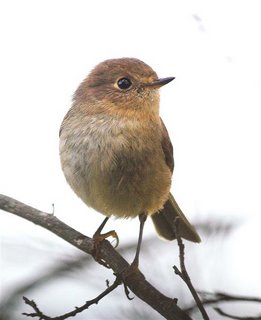 ould be welcome. I'll add another angle image.
ould be welcome. I'll add another angle image.Wednesday, June 21, 2006
Wedgetail Encounter
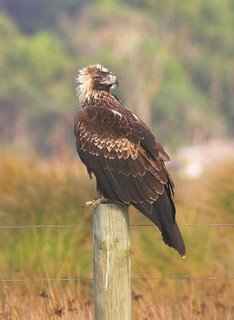 I have a confession to make! Although I wrote about visiting duck haunts in the previous blog, the real highlight of the morning was an encounter with a Wedge-tailed Eagle. I feel so much better now!
I have a confession to make! Although I wrote about visiting duck haunts in the previous blog, the real highlight of the morning was an encounter with a Wedge-tailed Eagle. I feel so much better now!I had driven along the Marion Bay Rd. towards Dunalley, and among the birds I noted were 2 Wedgetails sitting together on the branch of a dead tree some way up the bank and overlooking Blackman Bay. They were still there when I came back and although I tried photographing them they were too far away. I then crossed the causeway towards the beach, photographing a Little Egret on the way, and then on to the Long Spit Rd.. Whenever I go down this 'road' (it's deteriorating fast) I always keep an eye on the fences. Often there will be a bird of prey, chats, swallows etc. using the fence as a perch to view over the open paddocks/marsh. I noticed an obvious bird of prey in the distance on the fence, but a paddock away, but as I drew closer, I realised it was "big". I stopped and took the shot at top left, surprised that it allowed me to get so close. Three Wedgetails in 10
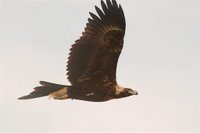 minutes! It finally took off towards the spit and I managed a few more shots before I lost sight of it. I moved on to the end of the road, and was preparing to walk to the beach, when it flew out of the tree I'd parked under!! If that wasn't enough it came back for a second run, unfortunately from a photographic standpoint, with the sun right behind it. The shot at left is of poor quality, but is the full frame 'as shot', which may give a
minutes! It finally took off towards the spit and I managed a few more shots before I lost sight of it. I moved on to the end of the road, and was preparing to walk to the beach, when it flew out of the tree I'd parked under!! If that wasn't enough it came back for a second run, unfortunately from a photographic standpoint, with the sun right behind it. The shot at left is of poor quality, but is the full frame 'as shot', which may give a n idea of how close it came. In the idiom of the day, "awesome".
n idea of how close it came. In the idiom of the day, "awesome".Tuesday, June 20, 2006
Ducks Abound
Drove round several of the local (Eastern Shore) duck haunts this morning and noted an increase in the numbers 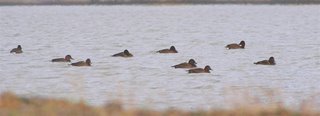 over last month. Of most interest was the flock of 32 Hardheads (part of the flock top left) at the Orielton Settling Ponds, a spot that more often has a modest flock of Wood Duck. Moved on to Lewisham, where the, fast drying out, 'duck pond' alo
over last month. Of most interest was the flock of 32 Hardheads (part of the flock top left) at the Orielton Settling Ponds, a spot that more often has a modest flock of Wood Duck. Moved on to Lewisham, where the, fast drying out, 'duck pond' alo ngside the road, had the usual Chestnut Teal, 3 Black-fronted Plover, and 6 pairs of Bluewinged Shoveller (1 male pictured at right). On to Blackman Bay area, where there were over 300 Chestnut Teal feeding on the exposed areas of the bay. On a small farm dam near Copping sports ground, that I could almost jump over, there were c.60 Black Duck. It's noticeable that many of the duck have paire
ngside the road, had the usual Chestnut Teal, 3 Black-fronted Plover, and 6 pairs of Bluewinged Shoveller (1 male pictured at right). On to Blackman Bay area, where there were over 300 Chestnut Teal feeding on the exposed areas of the bay. On a small farm dam near Copping sports ground, that I could almost jump over, there were c.60 Black Duck. It's noticeable that many of the duck have paire d and chase of suitors if they get too close to mates. Noted a pair of nesting Masked Plover (with eggs) at Marion Bay.The Chestnut Teal
d and chase of suitors if they get too close to mates. Noted a pair of nesting Masked Plover (with eggs) at Marion Bay.The Chestnut Teal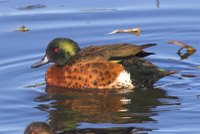 pictured (female left, male right) were photogaphed at Lewisham. [Lewisham 'pond' is a relatively easy spot to photograph various waterfowl, particularly if you use the car as a hide]
pictured (female left, male right) were photogaphed at Lewisham. [Lewisham 'pond' is a relatively easy spot to photograph various waterfowl, particularly if you use the car as a hide]
 over last month. Of most interest was the flock of 32 Hardheads (part of the flock top left) at the Orielton Settling Ponds, a spot that more often has a modest flock of Wood Duck. Moved on to Lewisham, where the, fast drying out, 'duck pond' alo
over last month. Of most interest was the flock of 32 Hardheads (part of the flock top left) at the Orielton Settling Ponds, a spot that more often has a modest flock of Wood Duck. Moved on to Lewisham, where the, fast drying out, 'duck pond' alo ngside the road, had the usual Chestnut Teal, 3 Black-fronted Plover, and 6 pairs of Bluewinged Shoveller (1 male pictured at right). On to Blackman Bay area, where there were over 300 Chestnut Teal feeding on the exposed areas of the bay. On a small farm dam near Copping sports ground, that I could almost jump over, there were c.60 Black Duck. It's noticeable that many of the duck have paire
ngside the road, had the usual Chestnut Teal, 3 Black-fronted Plover, and 6 pairs of Bluewinged Shoveller (1 male pictured at right). On to Blackman Bay area, where there were over 300 Chestnut Teal feeding on the exposed areas of the bay. On a small farm dam near Copping sports ground, that I could almost jump over, there were c.60 Black Duck. It's noticeable that many of the duck have paire d and chase of suitors if they get too close to mates. Noted a pair of nesting Masked Plover (with eggs) at Marion Bay.The Chestnut Teal
d and chase of suitors if they get too close to mates. Noted a pair of nesting Masked Plover (with eggs) at Marion Bay.The Chestnut Teal pictured (female left, male right) were photogaphed at Lewisham. [Lewisham 'pond' is a relatively easy spot to photograph various waterfowl, particularly if you use the car as a hide]
pictured (female left, male right) were photogaphed at Lewisham. [Lewisham 'pond' is a relatively easy spot to photograph various waterfowl, particularly if you use the car as a hide]Monday, June 19, 2006
Black & White
 There are two groups of birds that especially test the skills of photographers, the black ones and the white ones. While it's not difficult to actually take photographs of them, to show any plumage detail is. On the weekend I visited the Sorell Waterview Sanctuary, which is undergoing a clean up. It's difficult to find any shorebirds there these days, excluding the ubiquitous Masked Plovers. However there is no shortage of Forest Ravens, drawn in by the chicken factory. I would estimate that there were at least 200, and it was these that drew me there. I've tried several times to get shots of them in flight, but like the apocryphal story of crows and the farmer's gun , getting close enough to photograph them is difficult. Before I'd started trying to get to grips with t
There are two groups of birds that especially test the skills of photographers, the black ones and the white ones. While it's not difficult to actually take photographs of them, to show any plumage detail is. On the weekend I visited the Sorell Waterview Sanctuary, which is undergoing a clean up. It's difficult to find any shorebirds there these days, excluding the ubiquitous Masked Plovers. However there is no shortage of Forest Ravens, drawn in by the chicken factory. I would estimate that there were at least 200, and it was these that drew me there. I've tried several times to get shots of them in flight, but like the apocryphal story of crows and the farmer's gun , getting close enough to photograph them is difficult. Before I'd started trying to get to grips with t he ravens, an obliging Great Egret flew past, not once but twice! White birds also present a problem for photographers and over exposing the shots make it difficult to get any detail in the plumage. I was lucky as the egret flew past towards the early morning sun. Feeling that at least I had some shots to show for my morning, I turned my attention to the ravens. Black birds present a problem getting plumage detail, but in this case, overexposing shots is necessary. Not so lucky there! They were very wary, but I did manage the accompanying shot, but not quite the standard I was looking for. I shall return!
he ravens, an obliging Great Egret flew past, not once but twice! White birds also present a problem for photographers and over exposing the shots make it difficult to get any detail in the plumage. I was lucky as the egret flew past towards the early morning sun. Feeling that at least I had some shots to show for my morning, I turned my attention to the ravens. Black birds present a problem getting plumage detail, but in this case, overexposing shots is necessary. Not so lucky there! They were very wary, but I did manage the accompanying shot, but not quite the standard I was looking for. I shall return!
Saturday, June 17, 2006
Wintering Summer Birds
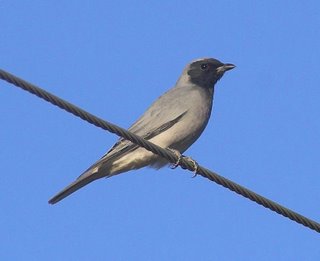 Once widely known as the Summer Bird, the Black-faced Cuckoo-shrike is in the main (as the old name implies), a Summer migrant to Tasmania. Locally, there's always a few that overwinter, mostly in coastal areas. During a recent drive around the South Arm area, I noted about 7 or 8 birds, all off which were alone. There was a time when there would be small flocks, of around half a dozen birds in each flock, wintering locally. Whether the smaller numbers represent a decline in the overall population or there are just less of them overwintering, is hard to gauge. My feeling is that I just don't see them as often these days, at any time of the year. In past Winters a small flock regularly sat on the powerline above a large Photinia bush in my front garden, flying down to catch insects off the foliage, but not this year. The accompanying image was taken at Clifton Beach.
Once widely known as the Summer Bird, the Black-faced Cuckoo-shrike is in the main (as the old name implies), a Summer migrant to Tasmania. Locally, there's always a few that overwinter, mostly in coastal areas. During a recent drive around the South Arm area, I noted about 7 or 8 birds, all off which were alone. There was a time when there would be small flocks, of around half a dozen birds in each flock, wintering locally. Whether the smaller numbers represent a decline in the overall population or there are just less of them overwintering, is hard to gauge. My feeling is that I just don't see them as often these days, at any time of the year. In past Winters a small flock regularly sat on the powerline above a large Photinia bush in my front garden, flying down to catch insects off the foliage, but not this year. The accompanying image was taken at Clifton Beach.
Thursday, June 15, 2006
More Gannets
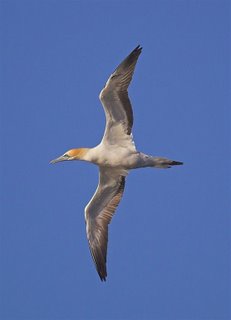 Another blustery Nor' Westerly wind in the River Derwent this morning and as I hoped, there were Australasian Gannets fishing fairly close inshore. If you want to photograph them, you have to be patient and be prepared to move to where they're fishing. I wasn't prepared. They were fishing in near mid Derwent when I first spotted them, but later moved into the lee of Bellerive Bluff. A dash home and a short drive enabled me to get close enough for the accompanying photos. I took a lot, but the birds were, in the main, just too far out. However, all was not wasted, as it gave me a chance to look more closely at their fishing technique. It really is amazing the control they can exercise when diving. With the use of feet as "air brakes" and a tail that acts as a "rudder", they can make subtle
Another blustery Nor' Westerly wind in the River Derwent this morning and as I hoped, there were Australasian Gannets fishing fairly close inshore. If you want to photograph them, you have to be patient and be prepared to move to where they're fishing. I wasn't prepared. They were fishing in near mid Derwent when I first spotted them, but later moved into the lee of Bellerive Bluff. A dash home and a short drive enabled me to get close enough for the accompanying photos. I took a lot, but the birds were, in the main, just too far out. However, all was not wasted, as it gave me a chance to look more closely at their fishing technique. It really is amazing the control they can exercise when diving. With the use of feet as "air brakes" and a tail that acts as a "rudder", they can make subtle  changes of direction to finesse their dive. It's not really apparent as you watch them, but single frames enable close inspection of their flying "attitude". You can see a little
changes of direction to finesse their dive. It's not really apparent as you watch them, but single frames enable close inspection of their flying "attitude". You can see a little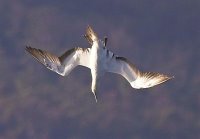 of this in the pictures. As I mentioned in a previous blog on Gannets fishing, I never tire of watching them. You might have to put up with more shots!
of this in the pictures. As I mentioned in a previous blog on Gannets fishing, I never tire of watching them. You might have to put up with more shots!
Wednesday, June 14, 2006
Introduced Or Not?
 I was drawing up a list of Tasmanian Birds recently, using a number of sources, and I came upon a dilemma. What constitutes an introduced species? Some sources included the Laughing Kookaburra and Corellas as introduced, others as, presumably, 'self introduced', across Bass Strait, and therefore acceptable 'Tasmanian' species. The Galah is known to have been introduced accidentally into the Huon area from a ship, in 1922. Perhaps those are the antecedents of birds that were frequently seen in the Kingston area for many years. However, the numbers now regularly seen around the State, would, I suspect, more likely be the progeny of birds having made the crossing from the Mainland. Nowadays, there are substantial flocks in many outer suburbs of Hobart, totaling some hundreds of birds. The Kookaburra, on the other hand, was known to have been introduced into the North and North East in the early part of the 20th century, and has gradually spread through the Island. Perversely, it is rarely listed as an introduced species. Perhaps it doesn't really matter except to the 'purist', and in many cases the question of the method of introduction of Mainland species, would be difficult to prove. The accompanying image of a Galah, was taken recently in the grounds of Clarence High School, Bellerive, one of the local flock numbering over 50 birds.
I was drawing up a list of Tasmanian Birds recently, using a number of sources, and I came upon a dilemma. What constitutes an introduced species? Some sources included the Laughing Kookaburra and Corellas as introduced, others as, presumably, 'self introduced', across Bass Strait, and therefore acceptable 'Tasmanian' species. The Galah is known to have been introduced accidentally into the Huon area from a ship, in 1922. Perhaps those are the antecedents of birds that were frequently seen in the Kingston area for many years. However, the numbers now regularly seen around the State, would, I suspect, more likely be the progeny of birds having made the crossing from the Mainland. Nowadays, there are substantial flocks in many outer suburbs of Hobart, totaling some hundreds of birds. The Kookaburra, on the other hand, was known to have been introduced into the North and North East in the early part of the 20th century, and has gradually spread through the Island. Perversely, it is rarely listed as an introduced species. Perhaps it doesn't really matter except to the 'purist', and in many cases the question of the method of introduction of Mainland species, would be difficult to prove. The accompanying image of a Galah, was taken recently in the grounds of Clarence High School, Bellerive, one of the local flock numbering over 50 birds.Monday, June 12, 2006
Kelps Cause Concern
 My blog on Pacific Gulls coincided with Birds Tasmania's Annual Gull Count in South East Tasmania -- reported in today's Mercury newspaper. About 10,000 gulls were counted, of which about half were reported from South Hobart and Glenorchy tips. The major finding was that both Silver and Pacific Gulls are in decline, but the only other species, the Kelp Gull, has continued to increase. Its' numbers have increased by about 8 times since 1980. As I have mentioned in previous blogs, the Kelp Gull has taken over large parts of Orielto
My blog on Pacific Gulls coincided with Birds Tasmania's Annual Gull Count in South East Tasmania -- reported in today's Mercury newspaper. About 10,000 gulls were counted, of which about half were reported from South Hobart and Glenorchy tips. The major finding was that both Silver and Pacific Gulls are in decline, but the only other species, the Kelp Gull, has continued to increase. Its' numbers have increased by about 8 times since 1980. As I have mentioned in previous blogs, the Kelp Gull has taken over large parts of Orielto n Lagoon as a breeding ground, and is breeding in small numbers in other important habitat. These habitats have been set aside for waders, both migratory and our own breeding birds. The invasive Kelp Gull is denying these areas to the very birds these areas were set aside for. The numbers of Kelp Gulls breeding and competing for nesting sites with Pacific Gulls on offshore islands is also likely to be the major cause of the decline in Pacific Gull numbers. There have been programmes of culling Silver Gull eggs, mainly on the causeways where they represent a driving hazard. I think it's past time to put in place a plan to reduce or eliminate Kelp Gulls from vunerable habitat. Too often there is a lack of pro active planning, preferring, apparently, to wait until an issue requires the expenditure of many dollars and employs the 'experts' who could have prevented it happening in the first place. It's past time to address this issue.
n Lagoon as a breeding ground, and is breeding in small numbers in other important habitat. These habitats have been set aside for waders, both migratory and our own breeding birds. The invasive Kelp Gull is denying these areas to the very birds these areas were set aside for. The numbers of Kelp Gulls breeding and competing for nesting sites with Pacific Gulls on offshore islands is also likely to be the major cause of the decline in Pacific Gull numbers. There have been programmes of culling Silver Gull eggs, mainly on the causeways where they represent a driving hazard. I think it's past time to put in place a plan to reduce or eliminate Kelp Gulls from vunerable habitat. Too often there is a lack of pro active planning, preferring, apparently, to wait until an issue requires the expenditure of many dollars and employs the 'experts' who could have prevented it happening in the first place. It's past time to address this issue.[Photos show, an adult Kelp Gull, and Silver Gulls (some of a flock of around 1000 birds at Sorell this morning)].
Saturday, June 10, 2006
Quite Still Please!
 During a quick walk round the block yesterday, I photographed this pair of Pacific Gulls. The image rather reminded me of those Victorian studio portraits of married couples, with one sitting in the chair and the other standing dutifully alongside. Perhaps the analogy isn't so far from the truth. Many of the local Southern Tasmanian headlands and beaches sport a pair of Pacific Gulls, who take up a sort of Winter territory. They don't seem to be bothered by the Kelp Gulls, but another adult Pacific entering the area can expect to be challenged. This is usually a 'sizing up' of one another, presumably by the males, which includes walking around each other on 'tiptoe', but can end in more aggressive behaviour if that doesn't work. At least they seem to behave with more decorum than the similar sized Kelp Gulls! A touching pair!
During a quick walk round the block yesterday, I photographed this pair of Pacific Gulls. The image rather reminded me of those Victorian studio portraits of married couples, with one sitting in the chair and the other standing dutifully alongside. Perhaps the analogy isn't so far from the truth. Many of the local Southern Tasmanian headlands and beaches sport a pair of Pacific Gulls, who take up a sort of Winter territory. They don't seem to be bothered by the Kelp Gulls, but another adult Pacific entering the area can expect to be challenged. This is usually a 'sizing up' of one another, presumably by the males, which includes walking around each other on 'tiptoe', but can end in more aggressive behaviour if that doesn't work. At least they seem to behave with more decorum than the similar sized Kelp Gulls! A touching pair! I've added this image to show part of the 'sizing up' of passing PGs. These 2 birds approached, making low guttural sounds, walked round one another holding themselves upright, until one bird backed down, then they continued on their way. It was all over in a minute and no contact was made.
I've added this image to show part of the 'sizing up' of passing PGs. These 2 birds approached, making low guttural sounds, walked round one another holding themselves upright, until one bird backed down, then they continued on their way. It was all over in a minute and no contact was made.Of course, this is only my interpretation of what's going on!
Friday, June 09, 2006
Powerful Tick
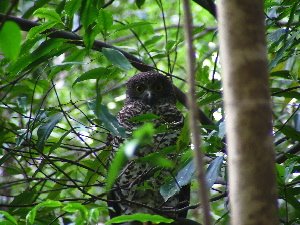 John Tongue writes: We're currently in NSW on holiday. Seeing good numbers of birds, considering most of our birding is being done from the car, while travelling between friends and relatives. We were VERY excited, though, after many years of searching, to be able to finally tick Powerful Owl, (a very little photograph is attached). We were steered in the right direction by a contact from the birding-aus e-mail list to a likely roost in Chatswood, Nth Sydney. We called in straight off the (doomed) Sydney ferry, and stumbled on it first up! It really is exciting to add a bird that you've been searching for, for some time.
John Tongue writes: We're currently in NSW on holiday. Seeing good numbers of birds, considering most of our birding is being done from the car, while travelling between friends and relatives. We were VERY excited, though, after many years of searching, to be able to finally tick Powerful Owl, (a very little photograph is attached). We were steered in the right direction by a contact from the birding-aus e-mail list to a likely roost in Chatswood, Nth Sydney. We called in straight off the (doomed) Sydney ferry, and stumbled on it first up! It really is exciting to add a bird that you've been searching for, for some time.
Wednesday, June 07, 2006
Who Only Stand and Wait.
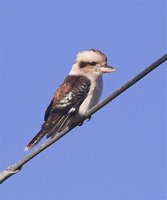 If you're driving around some of the outer suburbs of many towns and cities of Tasmania at the moment, you're bound to notice the number of predatory birds. Most of them sitting on wires and suitable shrubs, often for many minutes at a time, watching for some ill timed movement of potential prey. Most of the prey seems to be insects, which still seem surprisingly prevalent, despite the cold. I watched the Grey Butcherbird pictured here (bottom left), as it sallied from shrub top, to catch insects, most of which were grasshoppers, returning to the same perch to eat the catch. While most of the prey of the Brow
If you're driving around some of the outer suburbs of many towns and cities of Tasmania at the moment, you're bound to notice the number of predatory birds. Most of them sitting on wires and suitable shrubs, often for many minutes at a time, watching for some ill timed movement of potential prey. Most of the prey seems to be insects, which still seem surprisingly prevalent, despite the cold. I watched the Grey Butcherbird pictured here (bottom left), as it sallied from shrub top, to catch insects, most of which were grasshoppers, returning to the same perch to eat the catch. While most of the prey of the Brow n Falcons (bottom right) were also insects, the Brown Goshawk, (top right) photographed atop the perimeter fence at the Sorell chicken factory, appeared to have its eye on the small birds, mostly Starlings and Sparrows, attracted to the factory environs. I've seen what I assume is the same bird, on several recent visits. As I approached to photograph it on my latest visit, it was spooked by something at the factory and flew past me at no more than a few metres--far too fast to get a shot, but a memorable view none the less. By far the most numerous of the "wire sitters" are the Laughing Kookaburras, (top left) often in loose family groups. The one advantage of this "waiting" stategy, is that it requires much less expenditure of energy, at a time of reduced food and shorter days.
n Falcons (bottom right) were also insects, the Brown Goshawk, (top right) photographed atop the perimeter fence at the Sorell chicken factory, appeared to have its eye on the small birds, mostly Starlings and Sparrows, attracted to the factory environs. I've seen what I assume is the same bird, on several recent visits. As I approached to photograph it on my latest visit, it was spooked by something at the factory and flew past me at no more than a few metres--far too fast to get a shot, but a memorable view none the less. By far the most numerous of the "wire sitters" are the Laughing Kookaburras, (top left) often in loose family groups. The one advantage of this "waiting" stategy, is that it requires much less expenditure of energy, at a time of reduced food and shorter days.

Tuesday, June 06, 2006
Mud Walls Dam
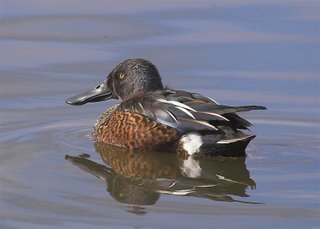 This large farm dam is one of my favourite birding spots. It's situated North of Colebrook, on the road to Oatlands, about a kilometre short of the Midland Highway junction. I ventured up that way yesterday in the frost and fog. Possibly because the birds were "grounded" by the fog, there were some hundreds of duck on it. It's one of those spots that you're better off staying in the car, and in a temperature well below zero C., I didn't need any convincing! Duck included c80 Blue-winged Shoveller (one pictured), c20 Grey Teal, 60+ Chestnut Teal, c80 Black Duck, 50+ Australian Shelduck, c30 Wood Duck, few Black Swan, a solitary Hoary-headed Grebe, and a very jumpy flock of around 15 Great Cormorant. There were also several Black-fronted Plover. The Grey Teal are always interesting, as we seem to go months or longer without seeing any, and then they seem to suddenly appear. When I first started birding in Tasmania I didn't see any for some years, and I was beginning to wonder whether I just couldn't pick them from Chestnut Teal. There followed a number of wet Winters, and they appeared in some numbers, and I realised that in reasonable light, they could be quite easily picked by their lighter coloured heads. I noted a similar number at Lake Dulverton later yesterday morning, also 8 Hardheads.
This large farm dam is one of my favourite birding spots. It's situated North of Colebrook, on the road to Oatlands, about a kilometre short of the Midland Highway junction. I ventured up that way yesterday in the frost and fog. Possibly because the birds were "grounded" by the fog, there were some hundreds of duck on it. It's one of those spots that you're better off staying in the car, and in a temperature well below zero C., I didn't need any convincing! Duck included c80 Blue-winged Shoveller (one pictured), c20 Grey Teal, 60+ Chestnut Teal, c80 Black Duck, 50+ Australian Shelduck, c30 Wood Duck, few Black Swan, a solitary Hoary-headed Grebe, and a very jumpy flock of around 15 Great Cormorant. There were also several Black-fronted Plover. The Grey Teal are always interesting, as we seem to go months or longer without seeing any, and then they seem to suddenly appear. When I first started birding in Tasmania I didn't see any for some years, and I was beginning to wonder whether I just couldn't pick them from Chestnut Teal. There followed a number of wet Winters, and they appeared in some numbers, and I realised that in reasonable light, they could be quite easily picked by their lighter coloured heads. I noted a similar number at Lake Dulverton later yesterday morning, also 8 Hardheads.
Sunday, June 04, 2006
Common Fate
 I wrote a blog a little while back entitled "Persecuted Cormorant". Shortly after that I received an e-mail from Priscilla Park pointing out that the Great Cormorant was not alone. In fact there are 4 species of birds that have no protection in law in Tasmania. If you or anyone else, want to shoot them, providing you have the necessary firearms permit, you can legally kill them. The species are those shown here--Forest Raven (a near endemic--if that's not a contradiction in terms!), the Tasmanian Native Hen, which is endemic to Tasmania, the Great Cormorant and the Little Pied Cormorant.
I wrote a blog a little while back entitled "Persecuted Cormorant". Shortly after that I received an e-mail from Priscilla Park pointing out that the Great Cormorant was not alone. In fact there are 4 species of birds that have no protection in law in Tasmania. If you or anyone else, want to shoot them, providing you have the necessary firearms permit, you can legally kill them. The species are those shown here--Forest Raven (a near endemic--if that's not a contradiction in terms!), the Tasmanian Native Hen, which is endemic to Tasmania, the Great Cormorant and the Little Pied Cormorant. 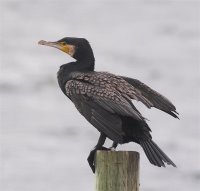 The Conservation Committee of Birds Tasmania has sought protection for these species, and regularly reminds the relevant authority of this. But decisions appear to get lost in that void, that we all know so well! The changes would almost certainly only mean that if you have an issue with these species, you would have to get a permit before shooting them. That doesn't seem too hard to me, and is the way that other species are controlled--on the merits of the case.
The Conservation Committee of Birds Tasmania has sought protection for these species, and regularly reminds the relevant authority of this. But decisions appear to get lost in that void, that we all know so well! The changes would almost certainly only mean that if you have an issue with these species, you would have to get a permit before shooting them. That doesn't seem too hard to me, and is the way that other species are controlled--on the merits of the case.Friday, June 02, 2006
Heron "Fishing"
 Hasn't been a great week for photographing birds, so on Thursday, more out of frustration than anything else, I visited the 'traps' on the Eastern Shore. Peter Willshire mentioned to me sometime back, that he had more pictures of White-faced Herons, than any other species, and after an hour spent watching and photographing this Heron, I can see why--they give you plenty of chances! Taken from the car in a rest area just North of the Bowen Bridge as the tide rose, this bird was obviously used to the vehicles parked close by. It seemed to be catching a fair bit of food, which I assumed was probably small fish. But after looking closely at the images, I found that in all cases, it was eating small crabs.
Hasn't been a great week for photographing birds, so on Thursday, more out of frustration than anything else, I visited the 'traps' on the Eastern Shore. Peter Willshire mentioned to me sometime back, that he had more pictures of White-faced Herons, than any other species, and after an hour spent watching and photographing this Heron, I can see why--they give you plenty of chances! Taken from the car in a rest area just North of the Bowen Bridge as the tide rose, this bird was obviously used to the vehicles parked close by. It seemed to be catching a fair bit of food, which I assumed was probably small fish. But after looking closely at the images, I found that in all cases, it was eating small crabs. If you click on the small image, you will see for yourself. Also at this spot were a few Pied Oystercatchers, Black-faced, Great and Little-Pied Cormorants, and the inevitable Silver and Kelp Gulls.
If you click on the small image, you will see for yourself. Also at this spot were a few Pied Oystercatchers, Black-faced, Great and Little-Pied Cormorants, and the inevitable Silver and Kelp Gulls.
Subscribe to:
Comments (Atom)

